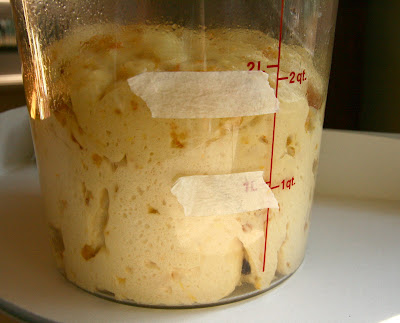
Think of a wonderful picnic in a meadow in early Spring (the day after Easter, for example). What would be in your picnic basket? That is the question posed by Italian blogger Cindystar, the host of April's Bread Baking Day (#21), as she chose the theme "Spring Country Breads":
"I would like to share with you a virtual pic-nic on Easter Monday. In Italy it's a popular tradition to have an outdoor trip in the countryside, on that special festive day all families and friends gather together, lay a blanket or a tablecloth on the grass and have a sort of epicurean brunch (never missing hard boiled eggs, part of tradition!)with children enjoy playing outdoor and adults lazily enjoying the first warm spring sun."I've recently made and posted two different types of typical sweet Easter breads (Hot Cross Buns, traditional in England, and a yeasted version of Dove Bread, an Italian favorite) and thought I'd try something different for this event. I paged through my bread books, and in Rose Levy Berenbaum's book The Bread Bible I found a lovely-sounding savory bread with an unlikely-sounding name: "Stud Muffin" (so called because it is studded with cubes of cheese before baking) She describes it as an Italian bread for Easter, a variation of a recipe from Perugia, Italy, called "torta di Pasqua" ("Easter cake" - although it is not a sweet one like the Colomba Pasquale/ Easter Dove.) How perfect! It's a bread intended for just the type of event Cindy evokes for us. And it's Italian!!
Stop by Cindystar in early May and see the roundup of Spring Country Breads. You are bound to be amazed at the wonderful creations of bakers literally all over the globe. This bread is also going to Susan at Yeastspotting, a fabulous weekly roundup of all things bready and yeasty. I'm always inspired by the handiwork of the bread baking bloggers!
Oh, and leave a comment on my 200th Post for a chance to win a $20 King Arthur gift certificate.

See those bits of browned gruyere?
- The baking pan is one of the keys to getting this bread to turn into a "muffin." My closest baking dishes were both 1.5 quart rather than 2 quart, so I prepared 3/4 recipe.
- I followed Beranbaum's directions for the "ultimate full flavor variation" which involved leaving the sponge at room temp for 1 hour, then in fridge for 8+ hrs, before incorporating it into the bread dough.
- Beranbaum gives detailed food processor instructions for preparing this bread. These are great because you use cold ingredients, rather than warm. The food processor tends to (over)heat the dough; generally you want to use your ingredients right from the fridge.
- I had a little bit of fun measuring my egg with the digital scale to get the appropriate 3/4 amount, but I'll spare you the gory details.
- My Parmesan cheese was Australian (shhh, don't tell Cindy!)
- The dough weighed 790 grams (Rose gives you the approximate weight of your finished dough, which is kind of cool)
- After hand kneading, the dough was incredibly soft and supple dough with flecks of black pepper. It was a total pleasure to work with the dough.
- The dough didn't rise much in the fridge, but as instructed I deflated it regularly just the same.
- The next day the dough rose very well - it's supposed to "nearly triple" and mine definitely did that. It deflated just a bit when I brushed the surface with egg. Luckily it puffed nicely in the oven. And smelled divine at the same time.
- After taking the bread out of the oven, the bread cools on its side on a soft pillow, to protect it as it's cooling. Apparently this bread is too fragile to stand on its base without collapsing. So it rests on a pillow for an hour, with lots of hovering by the proud mama/baker, who turns the bread every few minutes.

- I've wondered a lot of things in my admittedly short yeast-baking career. (Did I knead the dough enough? Did I add too much flour? Did I kill the yeast? Did I remember the yeast? Does my bread hate me?) But I've never thought I'd be asking myself: Is my bread resting comfortably? Is the pillow soft enough? Do I need to turn my bread to the other side for a few minutes? Perhaps a soothing lullaby?
the verdict:
After all of the sweets that have come out of my oven in the past couple of weeks, this bread was a breath of fresh air on a Spring day. Actually if you make this bread it might have you seriously wondering if you've died and ended up in heaven. Cue the harps; it's that perfect.

See those melty bits of Gruyere? Swoon!
Little bits of Parmesan and Romano cheese are dotted regularly throughout each slice of bread, and every now and then you hit the jackpot - a bread hole completely coated in Gruyere! And if that isn't enough, the black pepper is what puts this bread over the top. Well, and the fantastic moist crumb. Yum!!
I wanted to experience this bread the traditional way, so I took Beranbaum's suggestion and piled some prosciutto on a slice. It was the most perfect ham 'n cheese I've ever eaten!! Or imagined, for that matter. But as wonderful as that was, I most enjoyed this bread all by itself, just barely warm. It was also pretty great at room temperature. In fact this bread was so fabulously seductive that I had to put in the freezer after a day or two - just to avoid hearing it call my name. The cries are much more muffled through the freezer door.

the recipe:
I was unable to locate a link for this recipe, so I've gone ahead and typed it up the way I baked it - 3/4 recipe. I've slightly condensed/reworded too.
Stud Muffin
Rose Levy Beranbaum The Bread Bible
Here is the way that I prepared this bread. Beranbaum gives lots more specific information in her book, especially for various methods of mixing the dough. I used my food processor, which I think is her preferred manner for this formula.
1.5 quart soufflé or other deep round baking dish, well greased
baking stone (or baking sheet)
Sponge
117g (4.1 oz, or 2/3 cup + 1 T) unbleached all-purpose flour (Beranbaum specifies King Arthur, Gold Medal, or Pillsbury only – I used King Arthur)
1.8 g (½ tsp) instant yeast
133 g (4 oz, or ½ cup) water
In a medium bowl, whisk flour, yeast, and water until very smooth, to incorporate air, about 2 minutes. Will be the consistency of thick batter. Scrape sides of bowl, cover tightly with plastic wrap, and allow to stand for 1-4 hours at room temperature.
“Ultimate Full Flavor Variation”:
For best flavor development, allow to ferment for 1 hour at room temperature and then refrigerate for 8-24 hours.
Dough
42 g (1.5 oz) Parmigiano-Reggiano cheese, cut into chunks
42 g (1.5 oz) Romano cheese, cut into chunks
257 g (9 oz) unbleached all-purpose flour (same brands as above)
3 g (1 tsp) instant yeast
5 g (¾ tsp) salt
2 g (1 1/8 tsp) black pepper
42 g (1.5 oz, or 3 T) softened butter
88 g (3 oz, or 3/8 cup) cold water
¾ large egg (about 33 grams not counting shell)
53 g (1 ¾ oz) Gruyere cheese, cut into ¼ inch dice
In food processor with regular blade, process Parmesan and Romano cheeses until finely grated (powdery). Transfer to a bowl and switch to dough blade.
In medium bowl, whisk together all but about 21 grams of the flour, the yeast, salt, and the black pepper. Empty it into the food processor, and scrape the sponge on top. Add the butter.
In measuring cup with a spout, whisk together the cold water and egg. With the machine running, slowly pour the mixture into the feed tube. Stop the machine, add the grated cheese mixture, and process for about 15 seconds, until the dough forms a soft, shaggy ball. If the dough does not form a ball, add some of all of the remaining flour by the T, processing in 4-second bursts. The dough should feel slightly sticky.
Empty the dough onto a lightly floured counter and flatten it into a rectangle. Press 3/8 cup of the Gruyere cubes into the dough, roll it up, and knead to incorporate evenly. The cough will weigh about 780-788 grams.
Put dough in a lightly greased bowl, mark where doubled will be, then cover the bowl and refrigerate the dough 8-24 hours. Pat down several times in the first hour or two until the dough stops rising.
When you are ready to shape the dough, turn it out onto a counter and knead it lightly (It will be supple and smooth). Round it into a ball. Push down into prepared pan; it should fill the pan about half way. Cover lightly with a piece of wax paper and let rise in a warm area (80 – 85 degrees!) until almost tripled, about 3-4 hours. The center should be ½ - 1 inch above the rim of the dish.
45 minutes before baking, preheat the oven to 350 degrees. Have a shelf at the lowest position and place a baking stone or foil-lined baking sheet on it before preheating.
Brush the surface of the bread with a bit of lightly beaten egg. Insert remaining cubes of cheese into the dough using a chopstick; first gently twist chopstick into dough then use chopstick to push in a cheese cube, leaving it visible. This was tons of fun!
Place the dish on the hot stone. Bake for 40-45 minutes, until bread is golden and instant read thermometer registers 190 degrees.
Remove bread from the oven and set on a wire rack for 30 minutes.
With the tip of a sharp knife, loosen the sides of the bread and unmold the bread onto its side onto a soft pillow (covered with plastic wrap to keep it clean) on the counter to finish cooling. This will prevent the soft fragile sides from collapsing; turn it a few times to speed cooling, but always leave it on its side. It will take about an hour to cool completely.











































